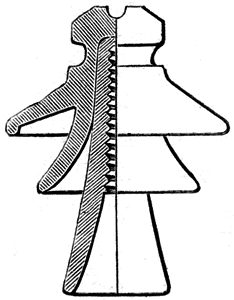[Trade Journal]
Publication: Electrical Review - London
London, England
vol. 55, no. 1393, p. 211-212, col. 2-1
HIGH PRESSURE INSULATORS.
[COMMUNICATED.]
THE following remarks about high pressure insulators may prove interesting to many readers of the ELECTRICAL REVIEW. The subject is an all-important one in these days of overhead transmission lines. There appears to be a considerable difficulty in making large insulators to withstand a testing pressure of from 50,000 to 70,000 volts, and makers are now taxing their powers to ingenuity to find the most efficacious and lasting form.
It is evident that there is much to be desired in the present form, as it is made in England. Practical experience has proved to English makers, as well as Continental, the advantage of making large insulators in two pieces as shown below, as they find it is impossible to make large masses of vitreous ware in one piece.
It has been found that small insulators made of good porcelain can easily stand pressures at, and above, 60,000 volts.
 |
| High Pressure Insulator. |
Foreign manufacturers have experienced breakages owing to screwing the spindle direct into the porcelain, and have found the necessity of wrapping the screwed ends with hemp or some other suitable material to allow for the unequal expansion of the iron stalk and the porcelain. The resistance of highly vitreous porcelain itself is practically unlimited, and the only leakage which can take place is caused by the moisture and dirt which collect on the surface; therefore, to be thoroughly good and efficient, an insulator should have as large a surface as possible, of which the greater part shoud be unexposed.
The following are the particulars of some tests of insulators made by an English firm. In the majority of cases the insulators have failed on account of some mechanical flaw. In a good many instances the weak point appeared to be the neck, although the thickness of porcelain at this point was much greater than that between the slot for the wire and the top of the stalk. This, no doubt, was due to the larger mass of porcelain at the neck not being properly vitrified. These tests are all at 60,000 volts for one hour's duration.
Test Percentage of breakdown at the end of 1 hour.
1 ......................................................................... 48 per cent
2 ......................................................................... 44 "
3 ......................................................................... 25 "
4 ......................................................................... 29 "
5 ......................................................................... 41 "
It is noteworthy that all these insulators were of one piece, whereas with the insulators made in two pieces, which were tested at the same time, no breakdown occurred.
